Support Us
Since 1979 more than 140,000 animals have been treated by Wildlife Rescue.
Thanks to the support of individuals like you, Wildlife Rescue can provide a lifeline for animals in distress.
Do you know you can set aside money for charity as part of your Will? You may have heard this called planned or legacy giving. And you’ll probably hear a lot more about it in the coming years: a Will Power study found a significant increase (5% to 8%) in Canadians donating to charity in their Wills.

That’s 1.2 million more Canadians giving in their Wills, creating roughly $37 billion in future charitable donations!
Think about how much good $37 billion could do – acres of forest saved, diseases eradicated, many people lifted out of poverty…
And countless wild animal lives saved and returned to their natural habitat.
One apparent reason is the economy forcing us all to hold our wallets a little (or a lot) tighter. Donating in your Will lets you make a significant difference without using the money you need now. Even leaving 1% of your estate to charity in your Will could make a substantial impact.

Coupled with an urgency to do something in the face of growing global need, gifts in Wills have become a popular solution. Inflation and cost of living may have put pressure on Canadian incomes, but the desire to help has never been stronger. This is a way for people to drive the kind of change they want, and it’s well within their reach.
Another reason is demographics. Canadians will pass down roughly a trillion dollars over the next 10 years, the biggest wealth transfer in history. It’s given many of us pause, realizing we probably will have enough to support family and a charity in our Wills.
Lastly, Canadians are just getting more creative with their giving by harnessing the power of Wills, RRSPs and other assets to give more strategically.
It might sound funny to think of your Will as a powerful tool for change in this world, but when it comes down to it, there are many benefits to donating this way:
Contribute more than you could otherwise.
Our donors are always amazed when we tell them how far their donations stretch and how much more we can do for BC’s wildlife with every extra dollar.
When we show them what a small percentage in their Will to Wildlife Rescue could look like, they do the math, and their eyes light up.
Remember that the value of your “estate” is the sum of any property and/or business you own, your pension and/or registered funds, securities like stocks or mutual funds, cash savings, and life insurance. It adds up, even if you subtract debt.
The average Canadian family in 2023 had a net worth of $981,816. If you put just 1% of that aside for charity, you could donate about $10,000 to your favourite cause! When else could the average Canadian make such an extraordinary impact?
Keep your memory alive in a unique way.
Talk about motivation – imagine the pride your children or grandchildren will feel knowing that you’ve contributed to providing the highest standard of care for sick or injured wildlife for generations to come. Or the honour it would be for them to be involved in giving orphaned or pollution-damaged wildlife a second chance to live a natural life.
When your loved ones have something positive and meaningful to associate with your memory, you will have created a legacy that future generations can rally around.
Tax breaks. Big ones.
Canada has some of the most generous charitable tax incentives in the world! In Canada, when you donate, you get a charitable tax credit, which can go a long way toward helping you pay down what you owe.
Your loved ones might need that charitable tax credit upon your passing because your estate will likely be taxed, and they will have to pay the bill. You can even structure your donation differently to get the biggest tax break possible.

A popular approach is to name a charity as a beneficiary of your RRSP (Quebec residents must name beneficiaries of their RRSP in their Will). The credit received will close to cancel out the taxes owed on this asset.
If you’re interested in learning more, you can always book a consultation with a financial advisor specializing in charitable giving.
It’s easier than you think!

Most donors have follow-up questions when they learn about the option to leave a portion of their Will to charity.
What about my family? I want to leave everything to them.
It’s possible to support both family and charity in your Will. Think about your Will in terms of percentages. If you set aside even 1% in your Will for charity, you can make a lasting difference (and lower taxes owed). And you’re still leaving 99% to support loved ones. It’s a win-win.
I don’t have much to give.
You might have more than you think. For example, donors are often surprised to hear that the RRSP or life insurance policy they have through work can be a smart way to give.
It’s worth taking stock of your assets. Even a modest amount can make a sizeable impact.
Do I have to be wealthy to leave a gift in my Will?
Not at all! Middle-income Canadians typically give this way. Do you know that the average donation made in a Will from the average Canadian is around $35,000? That’s the power of gifts in Wills!
How will I know what my gift accomplishes?
You won’t be able to see your gift in action, but when you leave a donation to Wildlife Rescue in your Will, you and your family become part of our Wildlife Community. We would love to hear how your vision matches our mission to save BC’s wildlife.
What if I change my mind?
Remember, you can always make changes to your Will. People generally update their Will at least a couple of times in their life.
You might also consider tools outside your Will to make a legacy gift. For instance, you can name a charity as a beneficiary of your RRSP or life insurance policy and make changes at any time. No hassle, no fuss.
Am I too young to be thinking about this?
If you have any assets, you’re not too young to be thinking about what happens to them. Without a Will, an executor or administrator will settle your estate according to provincial or territorial laws, which might not coincide with your values and wishes.
Everyone can leave a charitable gift from their estate, regardless of size. Your legacy reflects your life. It’s about the person you are, the values you demonstrate, and the example you want to set for others.

If you have any questions, Sheila, WRA’s Gift Planning Specialist, is happy to discuss more details with you. You can reach her at s.dickinson@wildliferescue.ca or 604-545-1421.
*Consult your financial advisor to ensure the gift aligns with your personal estate plan.
The Will Power campaign
Wildlife Rescue is a partner in Will Power, a national awareness campaign that encourages Canadians to use their Wills as a force for good. Together with Will Power, we want to connect people like you with resources to make the best decisions for their families, their future finances, and the causes that matter to them.
As avian influenza has been a hot topic over the past couple of months, we have received many questions from concerned wildlife enthusiasts about the virus. In this article, we address your questions and provide resources to stay up to date on avian influenza developments. For further information on avian influenza you can also refer to this article.
This avian influenza dashboard shows test results from across Canada.
In general, the risk to human health from wild birds infected with an avian influenza virus (both low and high pathogenic strains) is considered to be low. You can read more here.
However, since research regarding avian influenza is ongoing, it’s important to adhere to government guidelines, such as the recommendation to not handle sick wild birds.
You can find more government information and guidelines here.
The government recommends not to touch or handle sick birds or animals. Avian influenza is a respiratory disease. If you touch a sick bird or animal, then touch your eyes, nose, mouth or face, it is possible for you to get sick.
If you do touch a sick bird or animal, always wash your hands with soap and water and after removing gloves. Clean, disinfect or dispose of any potentially contaminated clothing, equipment or surface.
If you have touched or handled a sick or dead animal, watch for symptoms for 10 days after exposure. You can find additional guidance from the BC Centre of Disease Control here.
Currently, the Canadian government states: “There is no evidence to suggest that eating cooked poultry or eggs could transmit the virus to humans.” You can read more here.
Avian influenza, primarily adapted to birds, is not as easily transmitted to mammals. While much less common, many types of mammals have been infected including pigs, horses, dogs, domestic and wild cats, foxes, cows, goats, squirrels, mice, skunks, marine mammals, bears, mustelids, opossums and humans.
If your pet has been in contact with a sick bird, it’s important to monitor for symptoms. Fever, lethargy, eye infections, lack of appetite, difficulty breathing, or neurological issues (like seizures or tremors) are symptoms of avian influenza to look out for in dogs and cats.
If your pet is showing symptoms of avian influenza, contact your veterinarian immediately. If you do not have a vet, you can find the closest one to you here.
You can find additional information on how to protect your pet from avian influenza here.
Using a dedicated tub or laundry room sink may be wise to prevent splatter of any pathogens from bird feeders onto food preparation surfaces. Whether you clean your feeders in a sink, tub, or outside, we advise thoroughly disinfecting the area where you clean any feeders when you’re done. You can find additional feeder cleaning guidelines here.
When disinfecting any items it’s important to wear the necessary PPE, like gloves and a mask. Clean the contaminated area with soap and water and then disinfect the space and cleaning items.
Wash your hands with warm soapy water after removing your gloves. Be sure to dispose of the PPE and other contaminated items in a plastic bag.
Avian influenza is most prevalent in waterfowl and shorebirds, as well as any bird that scavenges or preys upon these birds i.e. birds of prey, gulls and corvids. However, other species may also become ill with avian flu.
Thus far, we are unaware of any reports of hummingbirds being affected by the avian influenza virus in Canada. If you’d like to stay updated about the species impacted by avian influenza, this government dashboard provides an up-to-date overview. Cornell Lab also shares a detailed list of affected species.
More commonly observed diseases among hummingbirds include fungal infections like candidiasis. This fungal infection causes a hummingbird’s tongue to swell, making it impossible for them to eat. As with other avian diseases, the spread of candidiasis can be prevented by cleaning feeders regularly.
You can find a detailed hummingbird feeder cleaning guidance here.
As the crisp air of fall sets in, many of us enjoy the vibrant colors and the cooler temperatures. However, for our feathered friends embarking on their journey south, this season poses significant risks.
Fall migration has started and the Wildlife Hospital has already seen a steep increase in birds admitted for window strike treatment in August and September. This uptick highlights the dangers migrating birds face as they navigate urban landscapes.
During migration, birds often travel at night and may be disoriented by city lights and reflective surfaces. Glass windows and railings, which can appear invisible to birds, present a deadly hazard. With their large windows and glass balcony railings, high-rise buildings are especially dangerous for migrating birds.

Window collisions are a leading cause of death for migratory and resident birds across the world. The stark reality is that these bird-glass collisions result in the death of approximately 25 million birds annually in Canada, a statistic reported by Global Bird Rescue.
Birds that have impacted a window often suffer from concussions, internal injuries, eye injuries, and fractured bones. Even if a bird seems to recover from an initial window strike, injuries can develop or worsen up to 48 hours later. This delayed effect makes immediate care from a trained wildlife rehabilitator critical for the survival of these birds.
There are several proactive measures you can take to help reduce window strikes and safeguard migrating birds:

If you encounter a bird that has collided with a window, it is important to seek help from a trained wildlife rehabilitator immediately. Contact the Wildlife Rescue Support Centre for assistance at wildliferescue.ca/report-an-emergency.
This year, Wildlife Rescue celebrates its 45th anniversary, marking decades of dedicated care thanks to the support of our incredible Wildlife Community. Your generosity today will support our vital work and help window strike victims recover. You can donate here.
By taking these steps, we can all contribute to creating a safer environment for our migrating avian neighbours. Let’s work together to ensure that every bird has a safe journey this fall!
Many of us like to give wildlife a helping hand by providing bird feeders over the cold fall and winter months. With various avian diseases spreading during these months, it is important to be mindful about offering food in a safe way. Ultimately, the goal is to do what is best for wildlife!
Wildlife Rescue notices an increase in birds presenting with contagious avian diseases, such as salmonella and conjunctivitis, during the colder months. Diseases can easily spread among birds sharing feeders because feeders attract large numbers of birds to one location.
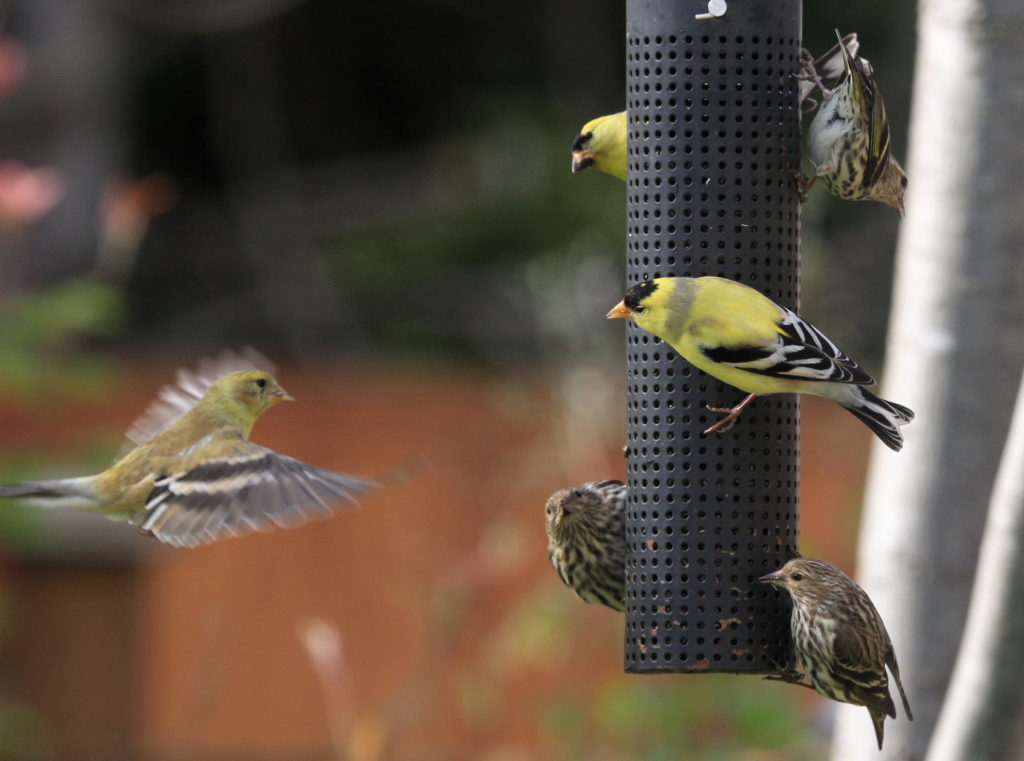
We can’t tell a sick bird not to come to the buffet, so sometimes it’s best just to postpone the dinner party before anyone else gets sick.
If you notice sick birds in your backyard, we recommend cleaning your feeders and putting them away for at least 3-4 weeks and until sick birds are no longer present in your backyard. This way you can help minimize the spread of avian diseases.
Here are a few symptoms to look out for:
If you are choosing to offer a feeder, we recommend taking the following steps to help keep wildlife safe:
Please note hummingbird feeders have a different set of recommendations.
Including native plants in backyard gardens is another effective way to provide food and shelter to wild birds over the fall and winter months. You will attract more wildlife visitors to your yard without needing to maintain a feeder.
These are some native species you can plant in BC:
Have you seen birds showing signs of disease, or do you have any questions? Reach out to our Support Centre for support and guidance here.
Thank you for looking out for your local wildlife!
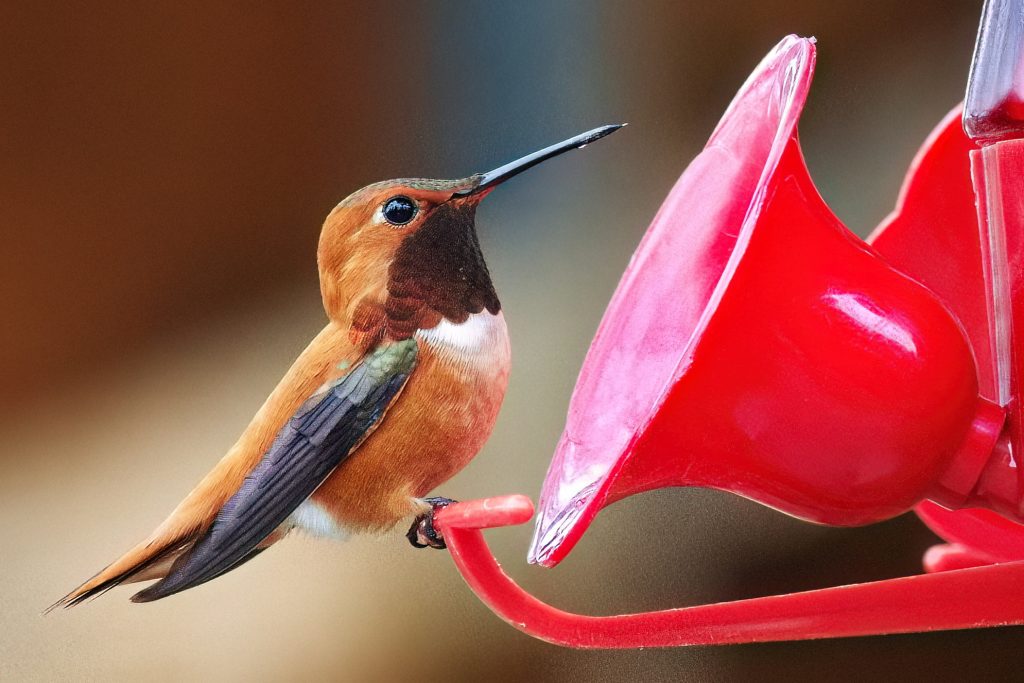
Hundreds of injured and orphaned wildlife patients arrive at Wildlife Rescue due to window and car strikes, nest disturbances, and natural and human disturbances.
Below is your step-by-step guide that takes you through the process of dropping off rescued animals.
Spring is duckling season, and with that comes a lot of questions about what to do when little baby ducks show up in unexpected places. Get your questions answered with our quick and handy Duckling FAQ! If you still have any questions, please contact our Support Centre.
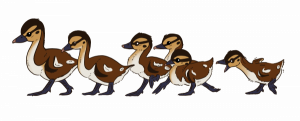
Like many bird species, the large and majestic Great Blue Herons are working away at nesting and laying eggs. While they’re not an uncommon sight around Vancouver, they are a species at risk in BC.
Despite their relatively large size, herons are extremely sensitive birds. The slightest human disturbance can cause a heron to completely abandon their nest. As herons nest in colonies of multiple families (also known as rooks), a group of herons abandoning a nest due to stress can be devastating.
What can you do to help? If you’ve noticed herons nesting near your home or favourite walking path, do your best to steer clear of the nest to prevent disturbing the birds. Keep an eye out for signs. Sometimes conservation officers will place them in the area to warn the public that a heron nest is nearby.
The above is especially true if you have a lovable canine friend. Dogs are a big disturbance for nesting herons, so be sure to keep your best friend close, on a leash, and well away from nesting sites on your daily walks this spring.
Your donations are critical to helping the local heron population! With your help, nests of orphaned baby herons can receive the care they need at Wildlife Rescue. Together, we can do our part to help these majestic, and sensitive, animals survive.
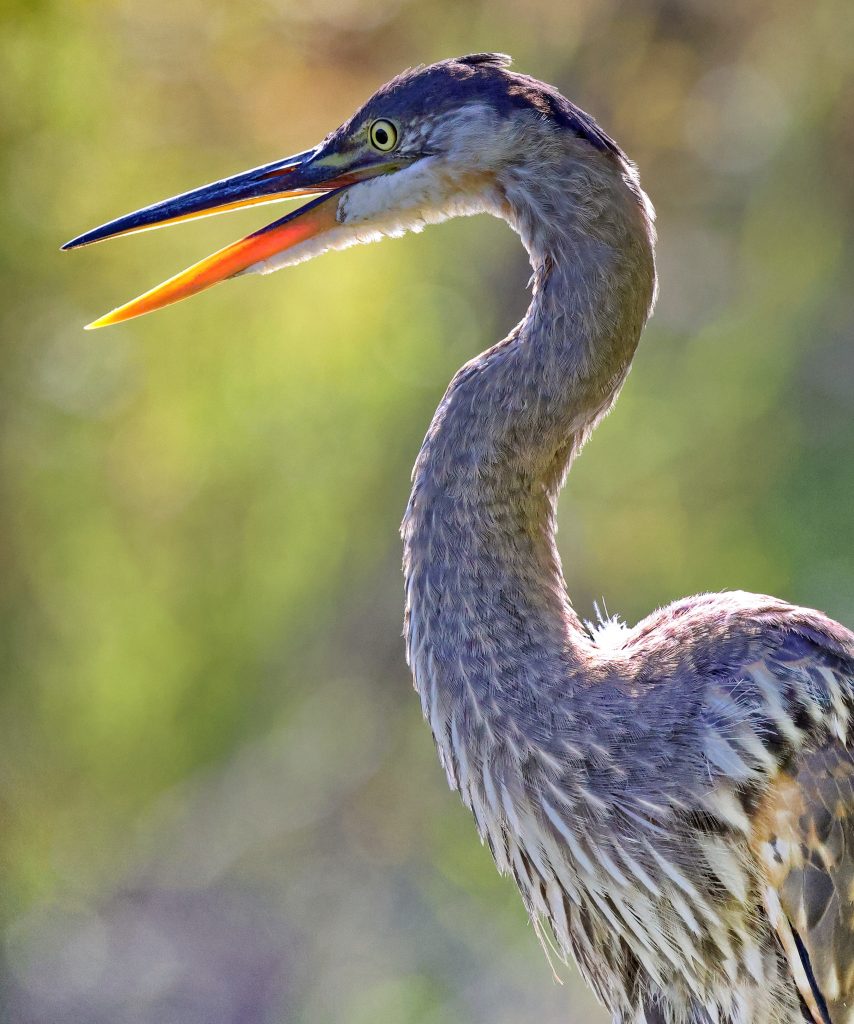
There are more babies on the way in spring than just birds! Coyotes are great at pest control, eating rats and mice, so it’s important to know how we can best share our environment with these tenacious wild animals.
Coyotes will form breeding pairs and begin having litters of puppies around this time of year. They are dedicated parents, and both males and females will stay with the litter. Coyotes are more visible at this time of year as they’ll be patrolling their territory with frequency. They might appear to act more aggressive, but in reality they’re just trying to keep their little ones safe. So, what can we do if we think there’s coyote activity in our neighbourhood?
Our friends at the Stanley Park Ecology Society have come up with the following guidelines for safe coexistence:
Most importantly, If you see a coyote, you can report the sighting to the Stanley Park Ecology Society here! This helps the conservation community know where activity is highest and can help keep people, pets and coyotes safe.
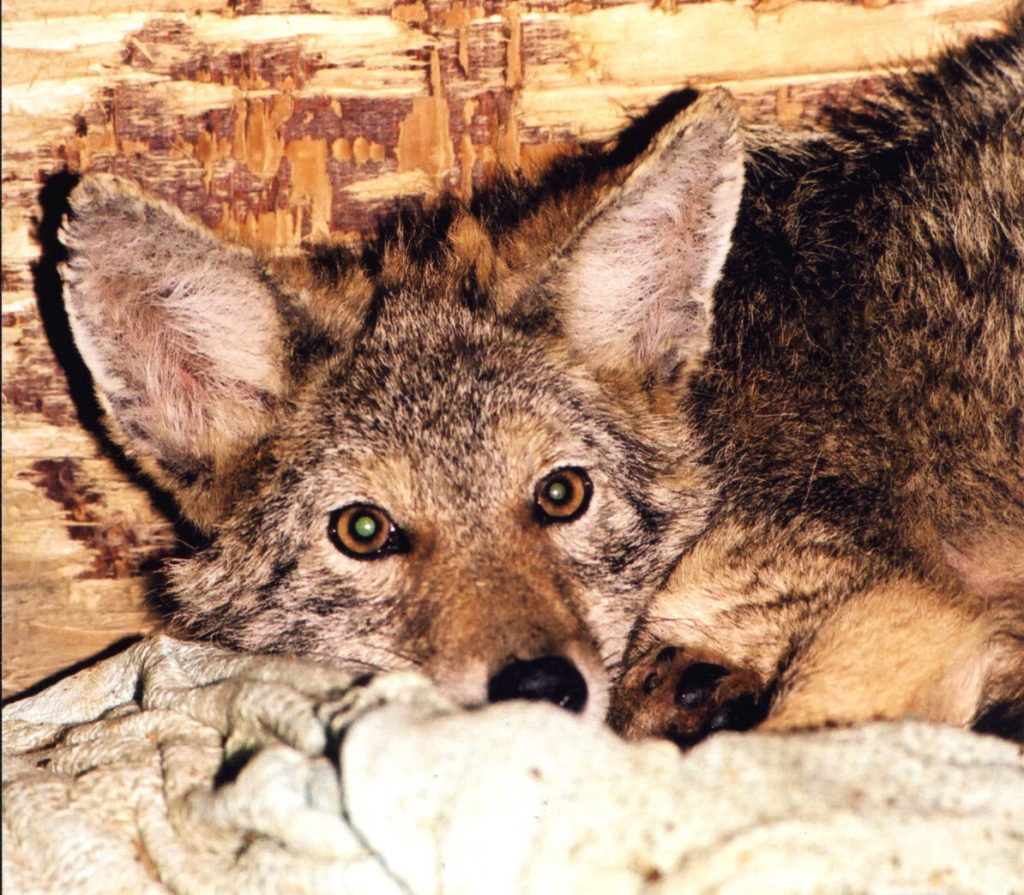
Now that spring is well on its way, many of us are looking to get started on the season’s gardening so that we can enjoy a beautiful outdoor space all summer. You can get your backyard ready for yourself and help wildlife at the same time this spring with these simple tips from the Wildlife Rescue team!
First, this weekend is looking like a great time to start trimming hedges and shrubs. Few species will have started nesting at this point, so you’re less at risk of disturbing a nest. Hummingbirds do settle down early, so be on the lookout for their little nests. Any cut branches you’ve left behind might then be snatched up to help build a comfortable home for other birds.
You may be tempted to keep going and start raking all those fallen leaves, but here’s a great excuse to put it off a little longer! Pollinators like bees and butterflies will overwinter under piles of insulating leaves. Wait until temperatures are consistently 10 degrees Celsius or higher before cleaning up to give these beneficial insects time to wake up for spring.
When it’s time to get planting, focus on native species for your balcony or yard. These species help feed hummingbirds and berry eaters, so your greenspace can support their foraging. As an added bonus, you’ll attract more wildlife visitors to your yard without needing to maintain a feeder.
In BC, plant native species, like…
As always, thank you for looking out for your local wildlife!
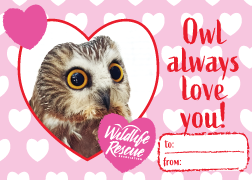
Robins are red,
Herons are blue.
Wildlife Rescue,
Made Valentines for you!
This collection of eight Valentine’s is free for you to download and print!